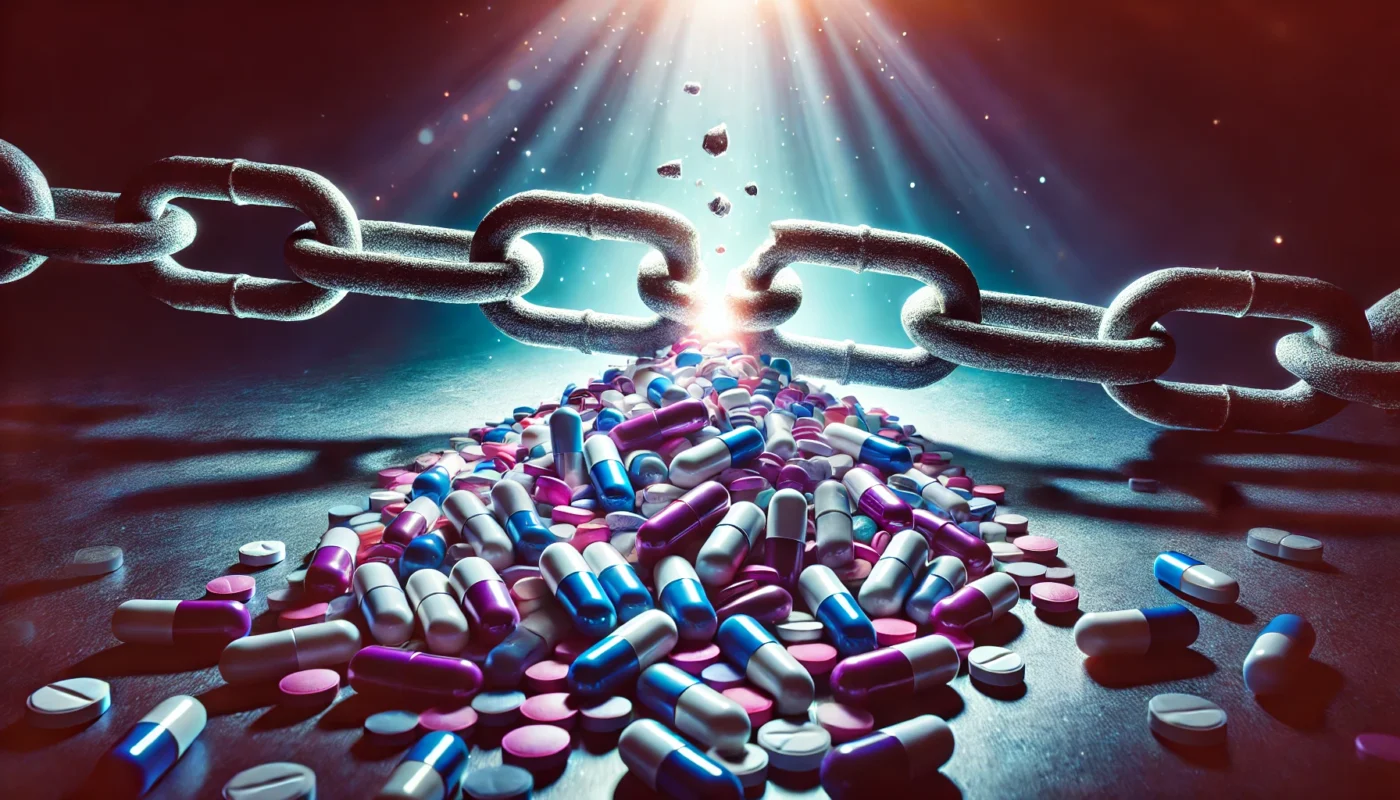Opioids are a class of drugs that include both prescription pain relievers, like oxycodone and morphine, and illegal drugs, such as heroin. These substances act on the nervous system to relieve pain, but they also carry a high potential for misuse and dependence due to their euphoric effects.
You may also like: Understanding Long-Term Pain Relief Options
Types of Opioids
Opioids can be broadly categorized into three types: natural, semi-synthetic, and synthetic. Natural opioids, such as morphine and codeine, are derived directly from the opium poppy plant. Semi-synthetic opioids, like oxycodone and hydrocodone, are chemically modified versions of natural opioids. Synthetic opioids, such as fentanyl and methadone, are entirely man-made and are often used in medical settings due to their potency.
Mechanism of Action
Opioids work by binding to specific receptors in the brain, spinal cord, and other areas of the body, blocking pain signals and releasing large amounts of dopamine, which encourages feelings of pleasure. This mechanism not only alleviates pain but also contributes to the potential for addiction, as the brain may become reliant on these artificially high dopamine levels.
Legal and Illegal Use
While many opioids are prescribed legally for pain management, their misuse often stems from their accessibility and the euphoric high they provide. Illegal opioids, like heroin, are often used recreationally and carry higher risks due to unregulated production processes, which can lead to unpredictable potency and dangerous contaminants.
Understanding Opioid Dependence
Opioid dependence is a medical condition characterized by the compulsive need to use opioids, even when they are no longer medically necessary. This dependence stems from changes in the brain’s chemistry caused by prolonged opioid use, which can lead to withdrawal symptoms when the drug is not available.
The Mechanics of Dependence
Opioid dependence begins with repeated exposure to the drug, leading to neurochemical changes in the brain. Over time, the brain adjusts to the presence of the drug, requiring higher doses to achieve the same effects—a phenomenon known as tolerance. As dependence develops, the absence of opioids triggers withdrawal symptoms, compelling individuals to continue using the drug to avoid discomfort.
The Progression to Addiction
Addiction is a chronic disease that goes beyond physical dependence, involving psychological and behavioral components. It often starts with voluntary use but can escalate to compulsive drug-seeking behavior despite negative consequences. Understanding the progression from use to addiction is crucial in identifying early signs and seeking timely intervention.
Impact on Life and Relationships
Opioid dependence can have profound effects on personal and professional life. It may strain relationships, impair job performance, and lead to financial difficulties. The stigma surrounding addiction can also prevent individuals from seeking help, exacerbating the issue. Recognizing these impacts is essential in fostering a supportive environment for recovery.
Side Effects of Long-Term Opioid Use
Long-term opioid use can lead to a range of side effects, impacting both physical and mental health.
Physical Side Effects
Gastrointestinal Issues
One of the most common physical side effects is constipation. Opioids slow down the digestive system, leading to chronic constipation, which can cause discomfort and other complications such as hemorrhoids and bowel obstruction.

Respiratory Complications
In high doses, opioids can severely impact the respiratory system, potentially leading to life-threatening conditions such as respiratory depression, where breathing becomes shallow and inadequate. This risk is heightened when opioids are combined with other depressants like alcohol or benzodiazepines.
Endocrine Disruption
Prolonged use can disrupt the endocrine system, affecting hormones such as testosterone and estrogen. This disruption can lead to issues like decreased libido, irregular menstrual cycles, and even infertility. Understanding these risks is crucial for long-term health management.
Psychological Side Effects
Cognitive Impairment
Opioids can affect cognitive functions, impairing attention, memory, and executive function. This can impact daily activities and overall quality of life, making it challenging to perform tasks that require mental clarity.
Emotional Instability
Users may experience fluctuations in mood, including depression and anxiety. These emotional changes can exacerbate the psychological need for opioids, creating a cycle of dependency and emotional instability.
Development of Addiction
The psychological need for opioids can become overwhelming, leading to addiction. This condition is characterized by compulsive drug-seeking behavior and use, despite adverse consequences. Recognizing the signs of addiction is vital for seeking appropriate treatment and support.
Strategies to Mitigate Risks
Managing pain and reducing the risks associated with opioid use require a multifaceted approach.
Holistic Approaches to Pain Management
Embracing holistic approaches can be an effective way to manage pain without relying solely on opioids.
Mindfulness and Meditation
Practices such as mindfulness can help manage pain by altering the perception of pain and reducing stress. Regular meditation can also improve mental well-being, providing a natural coping mechanism for dealing with discomfort.
Acupuncture
This ancient practice has been shown to relieve various types of pain and may serve as a complementary therapy. It involves inserting fine needles into specific points on the body to stimulate natural pain relief processes.
Physical Therapy
Engaging in tailored exercises can improve mobility and reduce pain over time. Physical therapy can also address underlying physical issues contributing to pain, providing a sustainable alternative to medication.
Diet and Nutrition
A balanced diet rich in anti-inflammatory foods can support overall health and potentially reduce pain levels.
Anti-inflammatory Foods
Incorporate foods like turmeric, fatty fish, and green leafy vegetables to combat inflammation naturally. These foods contain compounds that can help reduce pain and improve overall health.

Nutritional Supplements
Supplements such as omega-3 fatty acids and curcumin may also aid in reducing inflammation and managing pain. Consulting with a healthcare provider can help determine the appropriate supplements for individual needs.
Hydration and Detoxification
Staying hydrated supports the body’s natural detoxification processes and can help alleviate some of the physical discomforts associated with opioid use. Incorporating plenty of water and detoxifying beverages like green tea can enhance overall well-being.
Seeking Professional Guidance
For those at risk of opioid dependence, seeking guidance from healthcare professionals is crucial.
Pain Management Specialists
Consulting with pain specialists can help explore alternative pain management strategies. These professionals can provide tailored treatment plans that address individual needs without relying solely on opioids.
Mental Health Support
Engaging with mental health professionals to address any underlying psychological conditions that may be contributing to dependence is essential. Therapy and counseling can provide support and strategies to cope with emotional challenges.
Support Groups
Participating in support groups for individuals facing similar challenges can provide a sense of community and understanding. Sharing experiences and strategies can empower individuals to overcome dependence and adopt healthier lifestyles.
The Importance of Education and Awareness
Education and awareness are powerful tools in combating opioid dependence.
Staying Informed
By staying informed about the risks and side effects of opioid use, you can make educated decisions about your health and wellness. Accessing reliable sources and attending workshops or seminars can enhance your understanding of opioids and their impacts.
Community Engagement
Encourage open conversations within your community to reduce stigma and promote understanding of opioid dependence. This dialogue can empower individuals to seek help and adopt healthier pain management strategies.
Advocacy and Support
Advocating for better policies and support systems can contribute to broader societal efforts in addressing the opioid crisis. Supporting initiatives that promote education, prevention, and treatment can make a significant difference in combating the epidemic.
Conclusion
Opioid dependence is a complex issue, but with the right knowledge and resources, it is possible to navigate its challenges. By understanding the risks of long-term opioid use and exploring holistic pain management approaches, you can take significant steps toward safeguarding your health and well-being.

Stay informed, seek support, and consider alternative strategies to manage pain effectively. In doing so, you contribute not only to your own health but to the broader effort of addressing the opioid crisis. Educating yourself and others, engaging with healthcare professionals, and embracing holistic approaches are crucial steps in mitigating the risks associated with opioid use.
Further Reading:
Opioid complications and side effects
Long-Term Opioid Therapy Reconsidered
opioid dependence, opioid addiction, pain management, holistic health, mental health, substance abuse, opioid risks, drug dependence, pain relief strategies, community awareness, education on opioids, support groups, healthcare professionals, anti-inflammatory diet, mindfulness, physical therapy
Important Note: The information contained in this article is for general informational purposes only, and should not be construed as health or medical advice, nor is it intended to diagnose, prevent, treat, or cure any disease or health condition. Before embarking on any diet, fitness regimen, or program of nutritional supplementation, it is advisable to consult your healthcare professional in order to determine its safety and probable efficacy in terms of your individual state of health.
Regarding Nutritional Supplements Or Other Non-Prescription Health Products: If any nutritional supplements or other non-prescription health products are mentioned in the foregoing article, any claims or statements made about them have not been evaluated by the U.S. Food and Drug Administration, and such nutritional supplements or other health products are not intended to diagnose, treat, cure, or prevent any disease.

